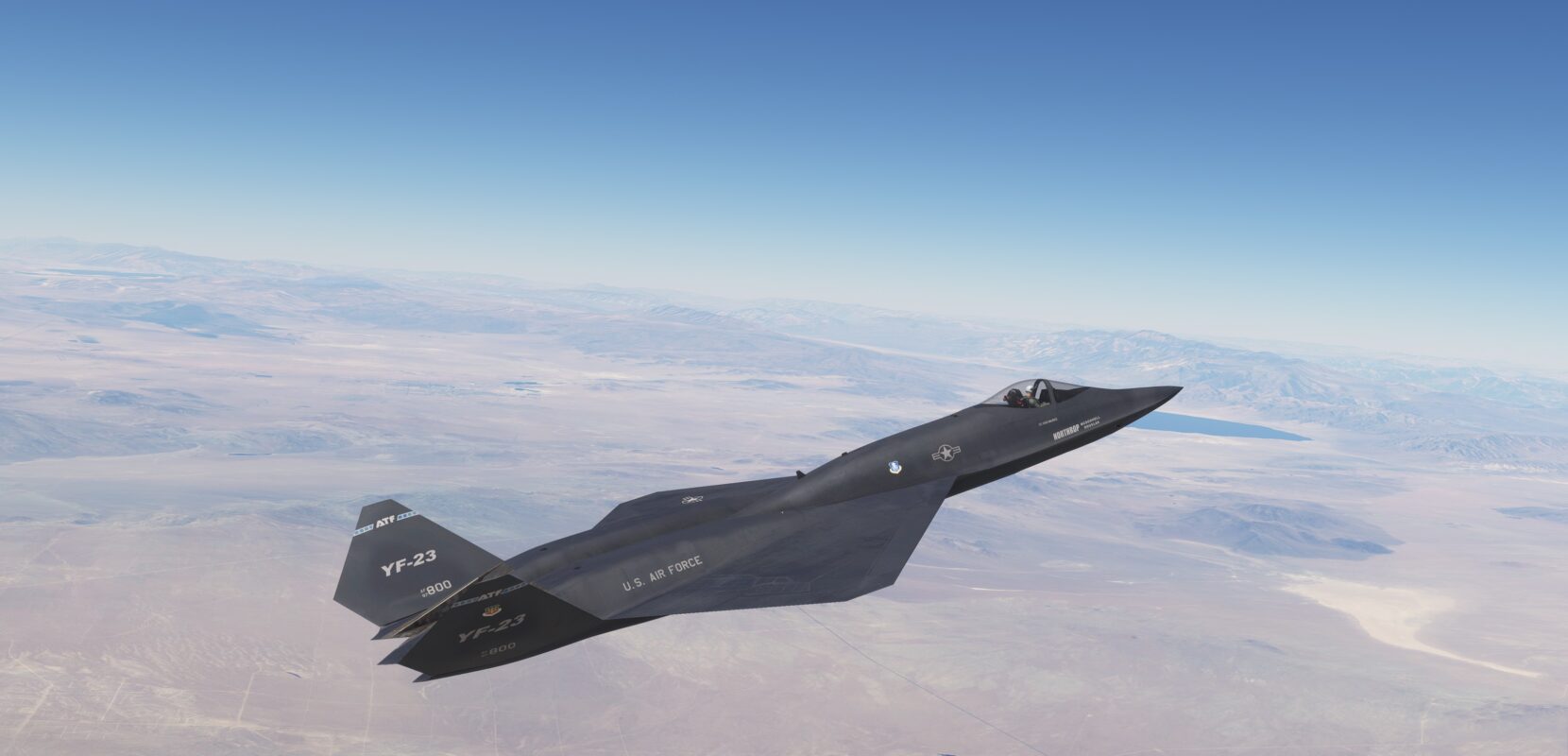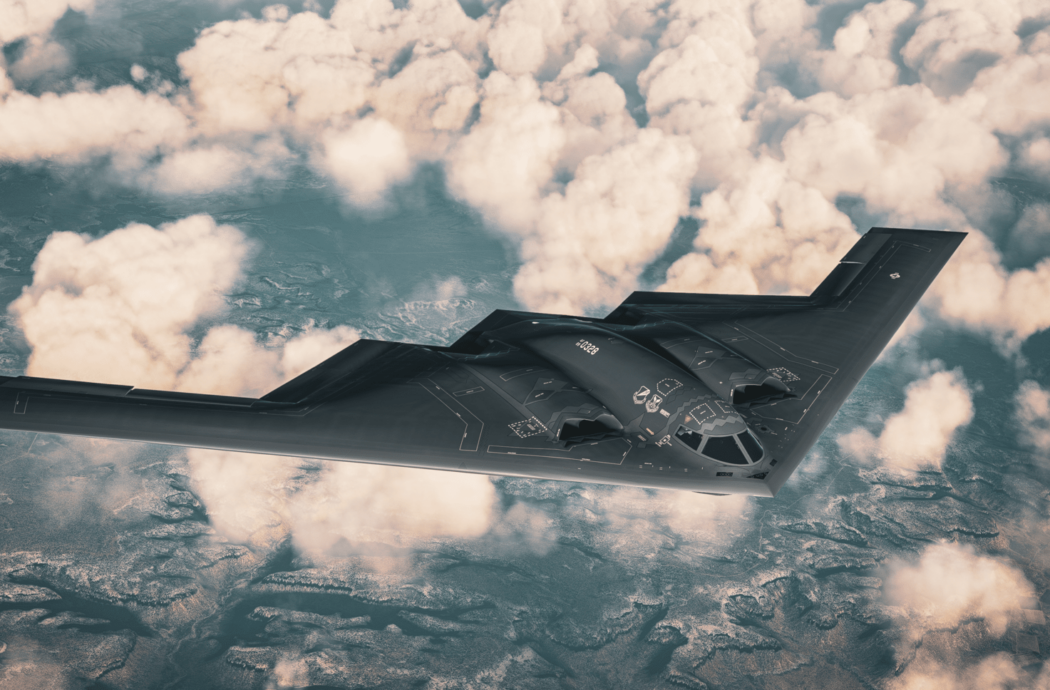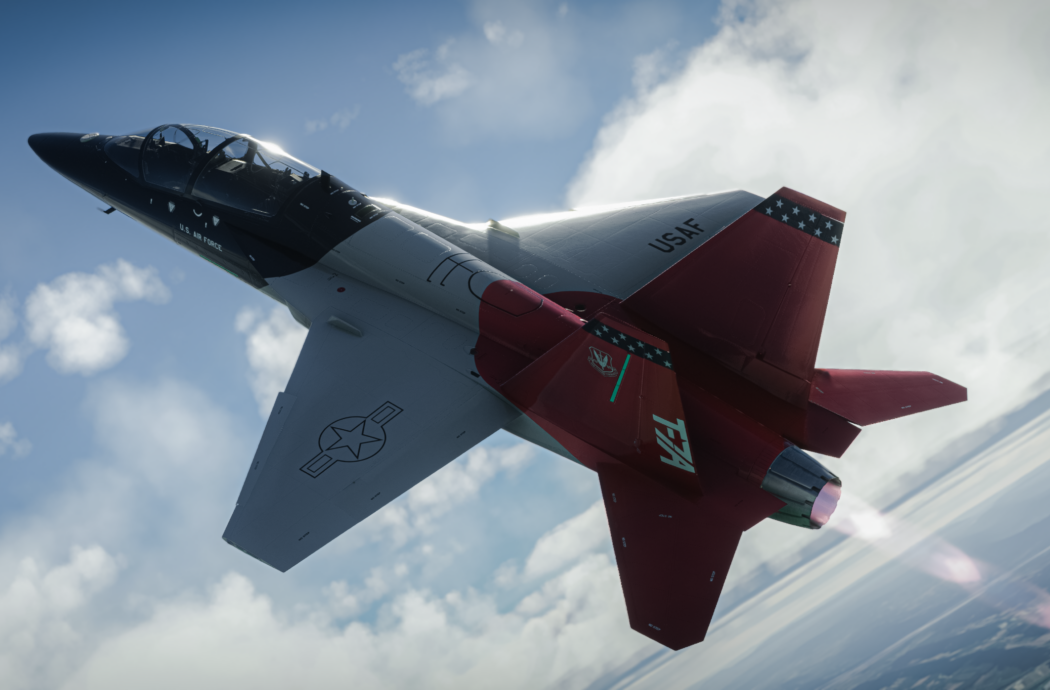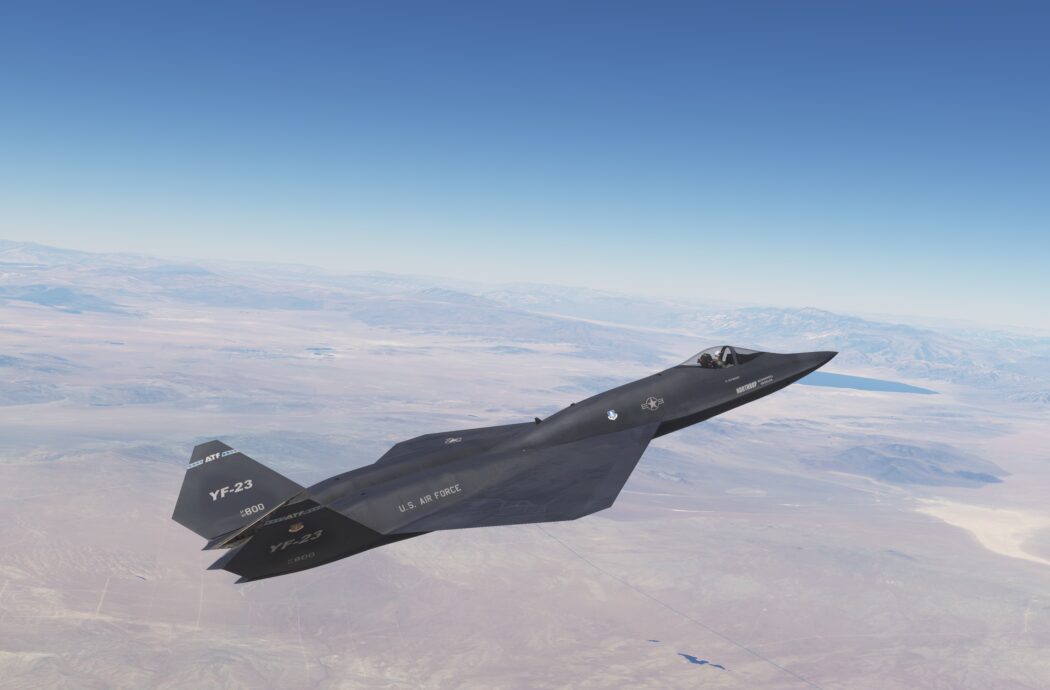
The Northrop/McDonnell Douglas YF-23A is an American single-seat, twin-engine, stealth fighter prototype technology demonstrator designed and submitted by Northrop for the United States Air Force’s (USAF) Advanced Tactical Fighter (ATF) demonstration and validation competition, battling Lockheed Martin’s YF-22 team for full-scale development and production. Nicknamed "Black Widow II", two YF-23 prototypes were built.
Our YF-23 features many unique and interesting capabilities and we’ve referenced the publicly available real-world YF-23 utility flight manual to replicate many of the aircraft’s unique features. We can say with certainty that there is nothing available for MSFS like this, and the Black Widow II will provide sim pilots of all abilities interesting piloting challenges and many hours of enjoyment.
Significant information about the YF-23A remains classified; in particular, estimated aerodynamic performance and maneuvering capability data. However, we’ve done our best, utilizing museum displays, the real world YF-23 utility flight manual (available online), photographs, books, videos, graphics, statements by the USAF, test pilots and engineers, and publicly known specifications, to replicate what we know about the YF-23A. In spite of some unavailable information about the real-world aircraft, we've rendered a sophisticated and realistic model of the Black Widow II that’s tremendous fun to fly.
We’ve modeled both real-world prototypes with different performance profiles as well as a hypothetical F-23A operational variant with additional features and performance capabilities. You get all three aircraft models in one package. This user manual describes use and function in all three variants.
Custom-programmed fly-by-wire control system:
- Auto-trim / pitch control
- G-limiter
- Roll and yaw limiters
- High angle of attack performance - controllable beyond 60 degrees AoA
- Computational fluid dynamics for improved aerodynamics and handling
- Highly resistant to departure from controlled flight
- Precision, stable flight control to 65,000 feet and above
- Custom-modeled flight control animations system
- Accurate take-off, approach and landing speeds
- Post-stall aerobatics possible; J-turns, pedal turns, power loops, etc.
Highly Realistic and Immersive Custom Sound Pack from Echo19 Studios
Highly detailed 3D cockpit – nearly 1:1
All displays custom programmed with reference to YF-23A utility flight manual:
- Head-Up Display (HUD)
- HSI screen and moving map for navigation
- Many functional cockpit controls; all cockpit controls are interactive & animated
- Custom canopy reflections and rain effects
- Full featured autopilot, IFR navigation capable
- Engine management controls modeled from flight manual
- Aerial refueling capability
- Complete cockpit lighting in operational variant
- 'Hidden' G3000 Flight planner
- High detail ACESII ejection seat model
- Custom, animated pilot figurine – user customizable display options
- Radar, Tactical display, and FLIR night vision in F-23A variant
Detailed custom-built 3D exterior model:
- 15 liveries included
- Accurate animation sequences for all flight controls
- Highly detailed, fully animated landing gear
- Ordnance bay animations and interior
- F-23A variant includes drop tanks and static weapons
- Custom dynamic vapor and vortex effects
- Custom afterburner and lighting vfx
- Complete exterior lighting systems for F-23A variant
- Custom ground and servicing equipment models
Performance and flight model based on USAF specs:
- Accurate weight and fuel quantities
- Engine model tuned to real-world specs
- Accurate fuel consumption and range
- Exceptional range allows long distance flights
- Mach 2.4+ maximum speed (faster for PAV-2 and F-23A variants)
- Super cruise at Mach 1.4+ at altitude (faster for PAV-2 and F-23A variants)
Other features and included items:
- VR headset compatible
- Ongoing development effort with ongoing upgrades planned
Model Variant Differences
We’ve included three variants of the YF-23 for your enjoyment, prototype air vehicles 1 and 2 (PAV-1 and PAV-2) and a hypothetical what-if F-23A. We initially considered modeling the F-23A after Northrop drawings of what the F-23A would have looked like, as well as a couple of poor-quality photographs/drawings of the real-world F-23A cockpit simulator that Northrop/McDonnell developed. We ultimately felt the development cost would be prohibitive, resulting in either an entirely separate product or a more expensive one, so we kept our ambitions reasonable and the development time and customer cost lower. Also, since the F-23A was only ever a “paper airplane”, we felt that modeling an F-23A from the PAV vehicle design was more conservative and allowed us to develop faster and keep systems and cockpits mostly common. Here are the chief differences from variant to variant:
- PAV-1 had lower engine performance of the two prototypes; the Pratt and Whitney YF119 was a less powerful and slightly smaller prototype version of the F119 that was ultimately installed in the production F22. As such the PAV-1 had lower performance results during testing. PAV-1 reached a super cruise speed of 1.43M and a maximum tested speed of M1.8 (with afterburner). PAV-1 also had a functional weapon bay system with doors that could be opened for testing during flight. While PAV-1 never carried weapons, the weapon bay and doors were tested for acoustic load and aerodynamic performance at supersonic speeds up to M1.5.
- PAV-2 had an early design of a variable cycle engine from General Electric, the YF120. During testing the aircraft reached publicly stated super cruise speeds of over M1.6, limited by test parameter restrictions, not ultimate engine / aerodynamic performance. GE engineers estimated super cruise speeds up to M1.8 could have been reached in unlimited testing. Maximum speed tested in PAV-2 was M1.8 with afterburner. PAV-2 had a weapon bay that was not designed for in-flight use. We haven’t restricted our model in this regard, but be aware of the real-life limitation.
- Our F-23a has the following differences from the PAV-1 and PAV-2 models:
- Heavier empty and max weights reflecting addition of avionics, structural reinforcement, and weapons carriage capability.
- Drop tanks and weapons can be added to the model allowing for visual weapon display, increased aircraft weight, and increased fuel capacity and longer ferry range; up to 30,000 lbs of fuel will give a range of at least 2,500nm at M0.85.
- More powerful engines, allowing a max super cruise speed of 1.9M+ and a maximum speed of well past Mach 2.2. in the game we’ve reached Mach 2.8 in perfect conditions at around 42000 feet. In the real world there are a variety of considerations in determining an aircraft’s ultimate maximum speed and a realistic ultimate allowed maximum Mach would likely be between M2.2 and M2.5.
- We’ve made the F-23A a little more maneuverable, able to reach slightly higher angles of attack (over 70 degrees aoa) and with a bit more pitch authority at high alpha than the PAV vehicles. In real-world testing the YF-23 vehicles were not flown above 25 degrees angle of attack, though they were demonstrated in wind tunnel and simulation to reach or exceed 60 degrees angle of attack trimmed. The F-23A is not quite as maneuverable as our F-22, but it will beat just about anything else out there and perform most of the same post-stall airshow type maneuvers as the F-22
- Stronger brakes. PAV-1 and PAV-2 had landing gear systems from the F-18 Hornet, which was a smaller aircraft and as such the braking system was not adequate for heavy / continuous braking. A production aircraft would have had a more capable braking system.
- A third MPCD / MFD display in the cockpit allowing for more display flexibility.
- Deletion of most of the test equipment switches and interfaces found in the PAV-1 and PAV-2 cockpit models
- Additional avionics including a simulated radar system with HUD integration, moving map display for the TSD screen, and a FLIR-type display.
- A complete cockpit and exterior lighting system. The PAV-1 and PAV-2 aircraft had no night-lighting systems – save for an in-cockpit utility light and two strobing anti-collision lights on the vehicle upper and lower centerline behind the cockpit.
















